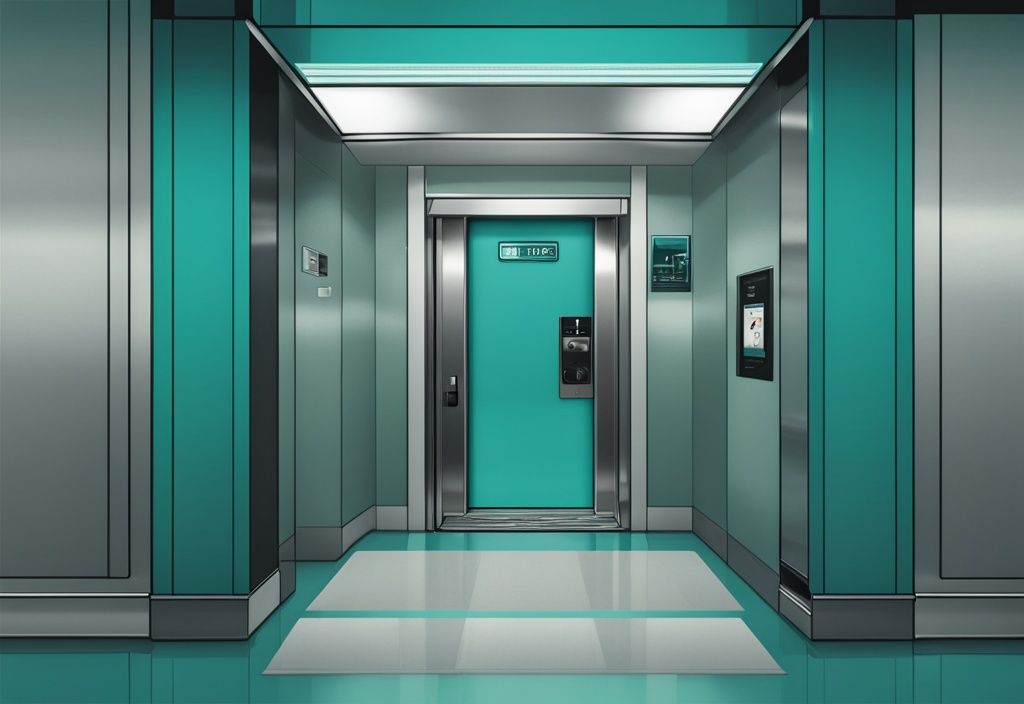Unveiling Mystery: Why Are Security Cameras Low Quality?
Ever watched a crime show and wondered why the security camera footage is always so grainy? You’re not alone. Many folks scratch their heads, asking, “why are security cameras so low quality?” especially given our age of technological advancements.
This article peels back the layers on this puzzling issue. We’ll delve into the nitty-gritty of design, environmental factors, and practical usage that affect the quality of security camera footage. We’ll also touch on the role of cost constraints and technological limitations in the equation.
So, if you’re thinking about investing in a surveillance system, stick around. Let’s unravel this mystery together and help you make an informed decision. After all, when it comes to safety, every detail matters.
Understanding the Quality Issues of Security Cameras
Security cameras often produce low-quality images despite significant technological advancements. This raises the question: why are security cameras so low quality? To understand this, it’s essential to recognize the distinct purposes and designs of different types of cameras. CCTV cameras and modern devices like phone cameras serve entirely different functions. While phone cameras are engineered to capture high-resolution images of specific targets, CCTV cameras are designed to capture everything within their range indiscriminately.
Surveillance cameras play a crucial role in keeping properties and people safe. They act as both a deterrent to potential criminals and a tool for post-event investigation. However, one of the most commonly cited criticisms is the grainy quality of CCTV footage. This is due to several limiting factors that affect the overall image quality.
Firstly, the primary design goal of security cameras is monitoring rather than producing high-quality images. The focus is on capturing a broad area to ensure comprehensive surveillance coverage. This wide-angle approach often results in lower image quality as the camera’s resolution is distributed over a larger field of view.
Secondly, security cameras must operate under various lighting conditions, which significantly impacts image quality. Poor lighting can result in grainy images, while excessive light can wash out details. Nighttime footage tends to be of even lower quality due to the reliance on infrared light and the switch to black and white mode.
Another factor contributing to the low quality is the compression of video files. To manage storage and bandwidth efficiently, CCTV cameras often compress video files, which can lead to a loss of image details and clarity. Multiple rounds of compression, from recording to storage to viewing, further degrade the video quality.
Finally, the materials and components used in manufacturing security cameras also play a role. To keep costs down, manufacturers often use cheaper materials, resulting in cameras that are more affordable but offer lower image quality. This cost-saving approach is practical for large-scale systems where high-definition cameras would be prohibitively expensive and require extensive storage space.
In summary, the question why are security cameras so low quality can be answered by considering their design purpose, environmental factors, and cost constraints. Despite their low image quality, security cameras effectively serve their primary function of monitoring and deterring crime.
Technological Factors Affecting the Quality of Security Cameras
Understanding why security cameras often deliver low-quality footage involves examining several technological aspects. Let’s break down the key factors that contribute to this issue.

Resolution and Compression: The Double-Edged Sword
One of the primary reasons why security cameras are so low quality is due to the compression of video files. CCTV cameras often compress footage to save on storage space, but this process can significantly reduce image quality. The aggressive compression algorithms used can result in the loss of crucial image details and clarity. While high-definition footage offers better quality, it also requires more data transmission and storage capacity. This makes low-resolution footage more manageable, especially for systems with limited resources. Furthermore, multiple rounds of compression—from recording to storage and finally to viewing—compound the degradation of video quality, emphasizing the trade-off between storage efficiency and image clarity.
The Role of Lens Quality in Security Cameras
Another factor contributing to why security cameras are so low quality is the use of subpar lenses. Most CCTV cameras are equipped with low-quality lenses, leading to soft, distorted images and limited zoom capabilities. Inexpensive cameras often feature fixed-focus lenses that do not provide sharp images across the entire field of view. The focus is usually preset and lacks the dynamic adjustment capabilities found in higher-end camera systems. As a result, the captured footage can appear blurry, particularly at the edges of the frame, which diminishes the overall effectiveness of the surveillance system.
Sensor Size: A Key Factor in Camera Quality
Sensor size plays a crucial role in determining the quality of security camera footage. Larger sensors can capture more light, enhancing performance in low-light conditions and improving dynamic range. However, many security cameras are fitted with smaller sensors to keep costs down, which significantly impacts image quality. Smaller sensors struggle to perform well in low-light environments, often resulting in grainy and noisy footage. This limitation is particularly problematic for nighttime surveillance, where adequate illumination is already a challenge.
File Format and Storage: How They Impact Quality
The file format and storage methods employed also explain why security cameras are so low quality. High-definition footage demands more data transmission and storage bandwidth, which can strain network and storage resources. To mitigate these issues, many security systems opt for lower-resolution video files that occupy less space. However, this approach sacrifices image quality for storage efficiency. Bandwidth constraints further exacerbate the problem, as transmitting high-resolution video in real-time requires substantial bandwidth, often unavailable in many surveillance setups. Consequently, the need to balance storage, bandwidth, and image quality leads to the prevalent use of low-quality security cameras.
Design and Purpose: Why Security Cameras Aren’t Built for High Quality
Monitoring vs. High-Quality Images: The Trade-Off
Security cameras are primarily designed to monitor movement and cover poorly lit areas rather than to capture perfectly styled images. The primary objective of CCTV cameras is to provide a broad surveillance capability, focusing on the range and coverage rather than the fine details of the footage. This approach helps in deterring potential criminal activities by ensuring that large areas are under constant watch. Therefore, the video quality is often compromised in favor of a wider surveillance range and the deterrent effect that the presence of cameras provides.
Field of View: A Compromise on Quality
Many security cameras are engineered to capture a wide field of view to monitor extensive areas effectively. This design choice means that the camera’s resolution has to be spread over a larger area, resulting in lower quality images. By aiming to cover as much ground as possible, the details in the footage may become less sharp, but this trade-off is considered acceptable for the primary purpose of surveillance. The broad field of view ensures that the cameras can detect motion and activities across a wide expanse, which is essential for security monitoring.
Fixed Focus and Motion Activation: How They Affect Quality
Security cameras often come with fixed-focus lenses and motion activation features. These preset configurations mean the cameras are not dynamically adjusting focus like a professional cameraman would. Fixed-focus lenses are typically set to cover a specific range, which might not always provide sharp images across the entire field of view. Additionally, motion-activated cameras rely on sensors to start recording, and if these sensors are defective or not finely tuned, the camera may not focus properly, leading to blurred or unclear footage. This fixed-focus setup is a cost-effective solution, prioritizing coverage and operational efficiency over image clarity.
Environmental Factors That Degrade Security Camera Quality
Understanding the environmental factors that degrade security camera quality can help you make better decisions about your home security setup. Let’s dive into the key elements that often lead to poor video quality.
Lighting Conditions: A Major Player in Camera Quality
Lighting conditions significantly impact video quality, which is a major reason why security cameras are so low quality. Inadequate lighting can lead to grainy images, making it difficult to discern details. Conversely, glaring sunlight can wash out important features, rendering the footage less useful. Nighttime footage typically suffers in quality as cameras switch to black and white mode and rely on infrared light. The effectiveness of this mode largely depends on the camera’s night vision capabilities and the amount of available outdoor lighting, which can vary significantly from one location to another.

Placement and Weather Resistance: Their Impact on Quality
Proper placement of security cameras is crucial for optimal image quality. Cameras should be positioned away from direct light sources to avoid glare and should be sheltered from adverse weather conditions. Many security cameras prioritize durability and weather resistance over image quality, which is another factor contributing to why security cameras are so low quality. Cameras designed to withstand harsh weather conditions often sacrifice advanced imaging features, focusing instead on longevity and robustness.
Wear and Tear: How It Affects Camera Quality Over Time
Over time, wear and tear can significantly degrade the quality of security cameras. Dirty lenses can obstruct the camera’s view, while defective image sensors can result in distorted or unclear footage. Older cameras tend to have lower resolution compared to newer models, leading to less sharp images. This gradual decline in quality is a key reason why security cameras are so low quality, especially in systems that haven’t been updated or maintained regularly.
Cost and Manufacturing Constraints: The Real Reason Behind Low-Quality Security Cameras
Ever wondered why security cameras often seem to lag behind in quality? The answer lies in a mix of cost, manufacturing choices, and technical limitations. Let’s break it down.
The High Cost of HD Cameras: Why They’re Not Common
High-definition (HD) cameras come with a hefty price tag and demand significant storage space, making them impractical for large-scale surveillance systems. The increased expense and storage requirements for higher video quality often lead companies to opt for more affordable, lower-quality cameras. This choice helps businesses manage costs effectively while still maintaining a basic level of security.
The primary goal of many security systems is deterrence and general monitoring rather than capturing high-resolution footage, making the investment in HD cameras less justifiable.
Cheap Materials: How They Lower Camera Quality
To meet lower price points, manufacturers frequently use inexpensive materials and components in security cameras. This cost-saving measure compromises the overall durability and reliability of the devices. Since most surveillance footage involves non-criminal activities, companies often prioritize quantity over quality.
The mere presence of security cameras can act as a deterrent, reducing the need for high-quality materials and components. Consequently, cheaper manufacturing practices result in cameras that are less effective in capturing clear, detailed images.
Storage and Bandwidth: The Hidden Factors Lowering Quality
High-definition footage generates a large volume of data, requiring substantial transmission and storage bandwidth. This can strain network and storage resources, leading to potential performance issues. To mitigate these challenges, many systems resort to lower-resolution footage, which is easier to manage but sacrifices image quality.
Storage limitations further impact the quality of security cameras, as high-resolution video files consume significantly more space. Additionally, bandwidth constraints can hinder the real-time transmission of high-quality video, prompting the use of aggressive compression techniques that further degrade image clarity.
Practicality and Usage: Why Low Quality Can Be Beneficial
Security cameras often serve more as a psychological deterrent than as tools for capturing high-quality footage. The mere presence of cameras can discourage potential criminals, making high-resolution images less critical. While high-quality footage might be beneficial for news dissemination or detailed investigations, the primary goal of many security systems is to prevent crime before it happens. This explains why security cameras are so low quality; the emphasis is on coverage and deterrence, not on producing broadcast-quality video.
Deterrent Effect vs. Image Quality: The Security Camera Paradox
Ever wondered why security cameras are so low quality? It’s a bit of a paradox. Cameras are there to scare off potential criminals, not to capture Hollywood-grade footage. Just seeing a camera can make someone think twice about committing a crime. High-resolution images are great for news or detailed investigations, but most security systems aim to stop crime before it starts. So, the focus is on coverage and deterrence, not on crystal-clear video.

Bulk Collection of Footage: Why Quality Isn’t Always Key
Think about how much footage a security system collects. It’s a lot, right? Most of it is just everyday, non-criminal activity. High-res footage eats up storage and bandwidth, which isn’t practical for large-scale operations. Many organizations find that low-res footage does the job. It’s enough for monitoring and reviewing incidents. This bulk collection focus is another reason why security cameras are so low quality. Managing high-quality footage is costly and complex, and for many, it’s just not worth it.
Slow Technology Adoption: How It Affects Security Camera Quality
Security cameras are often slow to adopt new technologies. Many organizations continue to use older cameras that have lower resolution, partly because these systems are already integrated into their security infrastructure. Additionally, the perceived adequacy of low-resolution footage for basic monitoring purposes means there is little incentive to upgrade. However, modern advancements like a light bulb security camera offer a discreet and higher-resolution alternative that can seamlessly integrate into existing setups. This slow adoption of newer, higher-resolution technology contributes to why security cameras are so low quality. Organizations prioritize functionality and cost-effectiveness over cutting-edge image quality.
Conclusion
Understanding why security cameras are so low quality is crucial when purchasing a surveillance system for property security. The quality of security cameras is influenced by multiple technical, environmental, and economic factors, which collectively contribute to the often disappointing footage quality.
From a technological standpoint, the resolution and compression methods play a significant role. High-definition footage requires extensive data transmission and storage, leading manufacturers to opt for lower resolutions to manage these constraints efficiently. Additionally, the use of low-quality lenses and smaller sensors further degrades the image quality, especially in low-light conditions.
Environmental factors such as lighting conditions, camera placement, and weather resistance also impact the final output. Inadequate lighting can lead to grainy images, while improper placement can result in obstructed views or exposure to harsh elements, which accelerates wear and tear.
Economically, the high cost of HD cameras and the need for extensive storage space make it impractical for many organizations to invest in high-quality systems. Manufacturers often use cheaper materials to keep costs down, prioritizing durability and deterrence over image clarity.
Despite the low quality, security cameras serve their primary purpose of monitoring and deterring crime effectively. The presence of these cameras alone acts as a significant deterrent, making high-resolution footage less critical for many users. Understanding these factors will help you make informed decisions when choosing a surveillance camera, balancing the need for quality with practical constraints.
Frequently Asked Questions About Security Camera Quality
Why do security cameras have low resolution?
Security cameras often have low resolution due to cost constraints in manufacturing. High-definition cameras are more expensive and require significant storage space, making them less practical for extensive surveillance systems.
How do lighting conditions affect security camera footage quality?
Lighting conditions greatly influence video quality. Poor lighting leads to grainy images, while excessive sunlight can wash out details. Nighttime footage suffers due to reliance on infrared light and black-and-white mode. For optimal results, it’s crucial to consider professional CCTV installation to address these challenges effectively.
Why aren’t high-definition security cameras commonly used?
High-definition security cameras are costly and demand large storage capacities. Many organizations find low-resolution footage adequate for basic security needs, reducing the impetus to invest in advanced, high-definition systems.
How does the placement of a security camera impact its image quality?
Placement is crucial for image quality. Cameras should be sheltered from weather and not directed at light sources. High-mounted cameras with broad views often struggle to capture detailed images, affecting overall footage quality.
How does compression reduce video quality?
Aggressive compression can significantly lower image quality by losing details and clarity. Multiple rounds of compression—from recording to storage to viewing—further degrade video quality, primarily to conserve storage space.
I’m James Albright, a home security expert with over 15 years of experience, and I’m passionate about helping families protect what matters most. After serving as a police officer, I transitioned to security consulting to share my hands-on knowledge and practical tips. My mission is to make home security simple and reliable by offering clear, no-nonsense advice and easy-to-follow guides. When I’m not reviewing the latest security tech or writing, I’m out in the community leading neighborhood watch programs and, most importantly, keeping my own family safe.





Post Comment